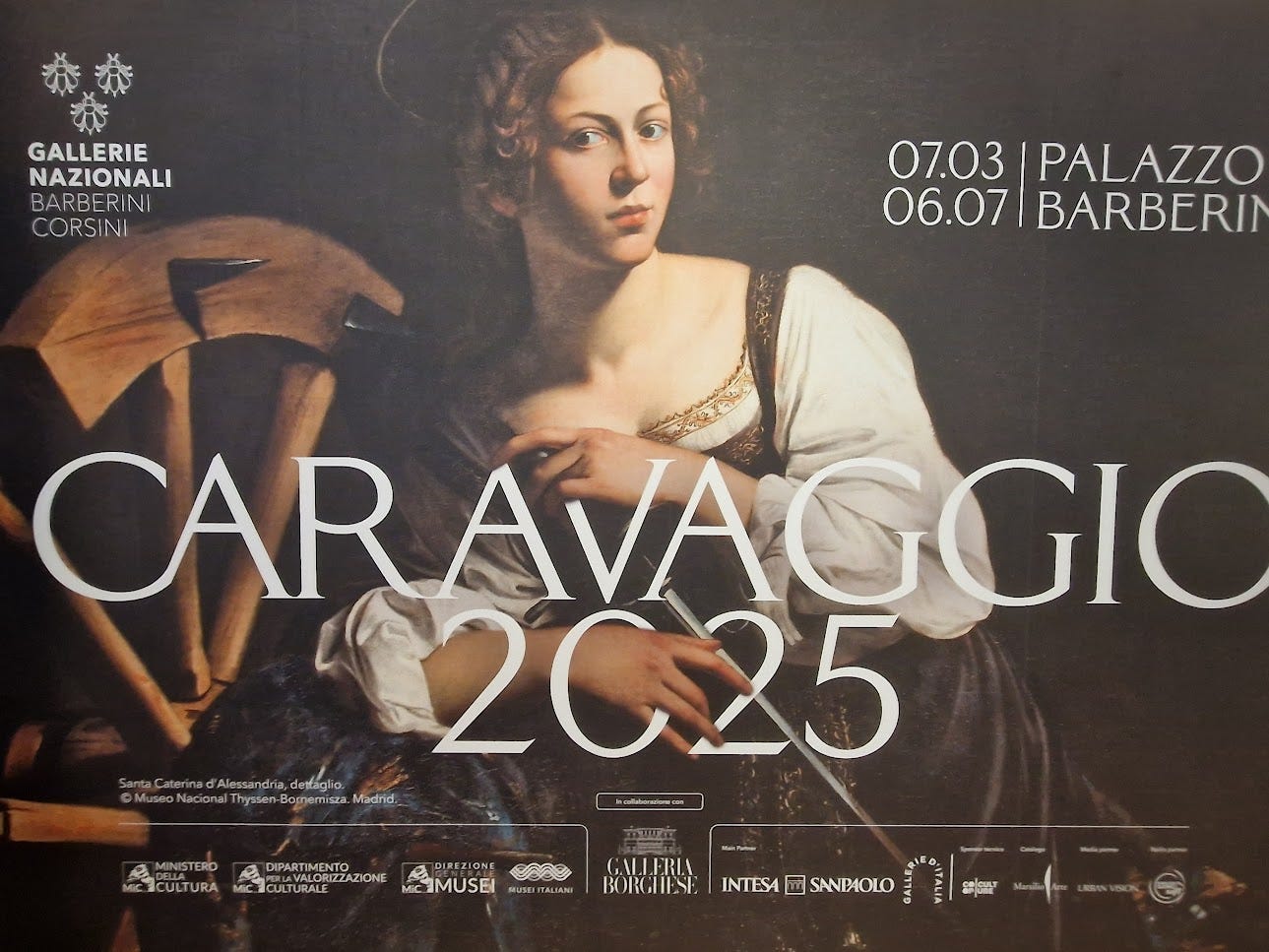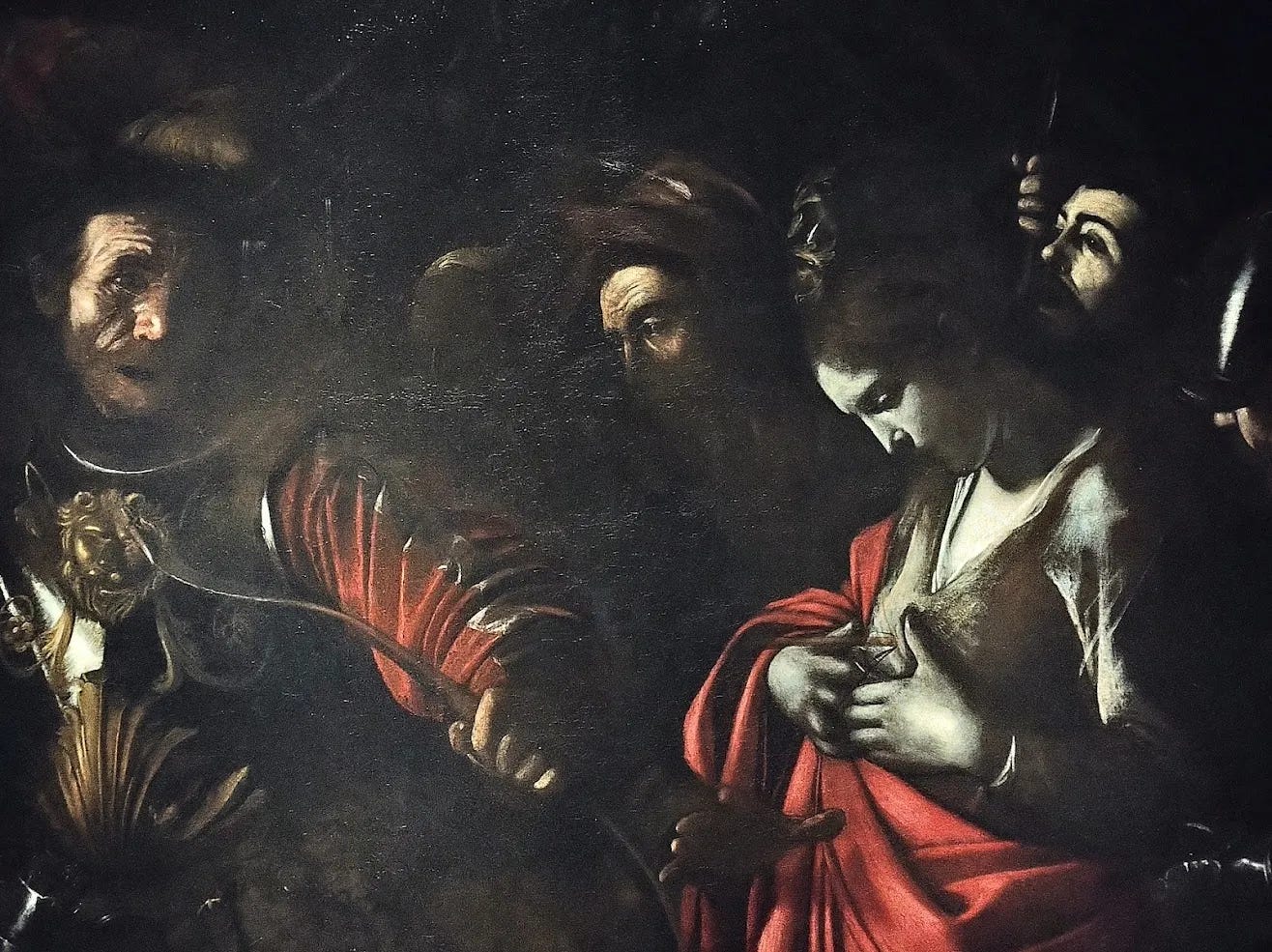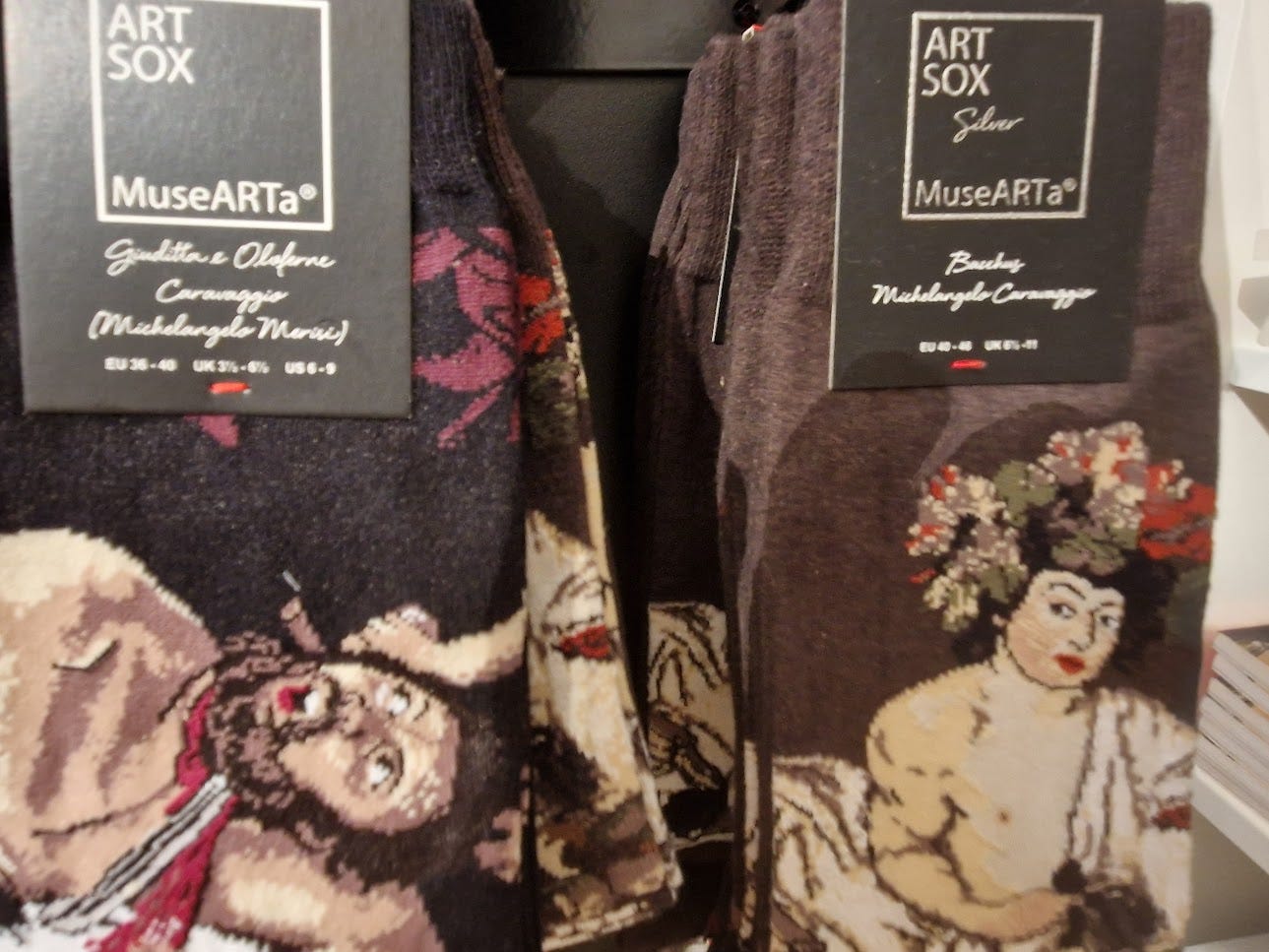In 1610 Michelangelo Merisi was desperate to return to Rome. By then he had endured four years in exile – one marked by flight, pursuit, threats, violence and imprisonment – and Rome was the city he believed he would find safe haven in. Along with well paid work.
That a Roman court had issued a death sentence (by beheading) to the painter known as Caravaggio – the nickname deriving from his hometown in northern Italy – which caused him, in 1606, to flee was no longer an issue, Merisi’s admirers in the Vatican having had his sentence annulled. He was, they knew, Europe’s greatest living painter and these pontiffs wanted him working for them again – what’s an occasional killing between hotheads, they surely reasoned, when it comes to genius? Of course, this tradition continues today, with Trump regularly freeing criminals connected to his vile regime.
Caravaggio never made it back to Rome, dying on his way there in the town of Porto Ercole, seemingly of a “fever” – much speculation about his death continues, with a recent report suggesting he died of sepsis resulting from a wound inflicted in Naples. He was 38 years old. I imagine many of his contemporaries, upon hearing of his passing, remarked how they were amazed he lived that long - mad, bad and dangerous to know, Merisi’s existence seemingly revolved around painting canvases suffused with violent revenge, suffering and temptation, then leaving the studio to indulge his tastes for the very same.
Caravaggio initially made his name with works like this one depicting card sharps.
Merisi’s life may have been brutish and brutal, but his art is sublime. Robert Hughes wrote “Caravaggio was one of the hinges of art history: there was art before him and art after him, and they were not the same.” Which is accurate: the beauty of Italy’s Renaissance painters, their striving for the divine, had descended into mannerism, a woozy art of bathetic gestures, until Caravaggio arrived and tore up the rule book.
In his mid-20s and hailing from Italy’s northern provinces, Merisi embarked on painting people and things with an uncanny realism. Caravaggio’s paintings evidenced a hunger for the real, a desire to reclaim the human figure, and he stunned Rome, then Europe’s epicentre of art and religion.
Success was almost immediate and, as we often see, acclaim and wealth can bring out an individual’s dark side. It certainly did with Merisi, his decade in Rome being pocked with incidents of violence and antagonism. That his paintings are beautiful yet confrontational – lewd youths grin at the observer, peasants with dirty feet pray before the Virgin, Christ calls on Matthew in a gloomy Roman tavern – surely shocked observers. They remain potent today, as the exhibition Caravaggio 2025 at Palazzo Barberini in Rome makes clear.
I heard about the forthcoming Caravaggio 2025 exhibition in February so booked a ticket immediately. For some inexplicable reason Caravaggio speaks to me more than any other painter and, while I have travelled to see his work – following his flight to Naples, Malta and Sicily - I’ve never previously had the opportunity to witness an exhibition. Also, I’d not set foot in Rome or Naples for many years, two European cities I enjoy more than most. A good reason then to return.
I’m pleased I did. So much so I aim to post a series of Yak reports on my sojourn amongst the Italians – Belle Italia I’ll call them – but for this one I will focus only on the dark master of Italian painting.
Saint Ursula is pierced by an arrow. The slings and arrows of outrageous fortune were constantly pricking Caravaggio and, upon finishing this canvas, he would soon turn to dust.
Having arrived and got in the queue at Palazzo Barberini at the time specified on your ticket (Caravaggio 2025 apparently sold out months ago, so don’t miss your slot!), the exhibition is divided into four rooms that chronologically cover his artistic life from arrival in Rome in 1592 (apparently fleeing arrest for an assault in Milan) on to what is believed is his final work, The Martyrdom of Saint Ursula, painted in Naples in 1610 and a painting that apparently accompanied Merisi on his fateful journey towards Rome.
I wrote on the Yak about the Ursula painting when it was loaned to London’s National Gallery last year; I’ll note here how it serves as a downbeat coda to his life’s work, rushed and rough as it is. Which sounds like an epithet for the doomed master.
Observing an artist’s life work, from young and hungry and still establishing his own signature style, through the heyday of success and on to work painted whilst a fugitive, right up to his bitter end, allows for a meditation on one man’s immense talent – Caravaggio may have behaved like a demon but he painted like an angel, so fluid was his technique, so lush were his saints and sinners, so dramatic his storytelling.
Initially he painted figures from Greek myth and Roman street scenes – his Gypsy fortune teller who is intent on loosening the youth’s ring – moving onto Bible scenes and Catholic saints (and the occasional portrait of a powerful patron) as the church began making good use of this wild, brilliant youth. Outside of his early street scene paintings, Caravaggio determined to cloak his subjects in darkness, manipulating light and shadow for dramatic effect, ensuring his subjects shimmer against the inky backgrounds.
The Fortune Teller is the work of a young, confident artist determined to describe the world he inhabits. Its so light and bright - even comic - compared to what he would soon be serving up.
I first connected with Caravaggio as a teenager, but it wasn’t via seeing a work of his in an art gallery – New Zealand doesn’t possess any old master paintings – instead, I went to an exhibition called Anxious Images in the Auckland City Art Gallery.
Anxious Images featured half a dozen contemporary Kiwi artists who, according to the curator, shared a theme of unease. One of them was Tony Fomison, and his work struck a chord with me like no painter previously. Admittedly, I’d not spent much time prior looking at visual art but this exhibition – and especially Fomison’s paintings – really connected. And, once I read up on Fomison, I learnt of Caravaggio and how Tony employed the Italian master’s chiaroscuro effect in his paintings.
A major biography of Fomison was published earlier this year in Aotearoa and I wrote on the book (and him) when there – I’ll endeavour to write on Caravaggio’s South Pacific disciple at some point on the Yak, he’s worthy of your attention, and wandering through Caravaggio 2025 I did think of Tony, how these paintings spoke to his outsider sensibility, helped him portray unease and discontent, anxious images from centuries ago which continue to resonate today.
“A body like that is on the verge of being obscene…” as Prince once sang. The Passion: this Caravaggio altarpiece surely fetishes Jesus as an icon of gay desire and masochism?
Caravaggio was never a painter of the pretty or the quotidian. His world was one of street people, thugs, hustlers, sex workers, who he transformed through oil paint into saints and martyrs (and executioners and cherubs and mourners). Essentially, he made poetry out of the urban milieu he immersed himself in.
Which surely accounts for his huge popularity today – why do I respond viscerally to Caravaggio? I don’t have a religious bone in my body, so there’s no “spiritual” engagement. There’s a bleak beauty to his paintings - and, while I have seen many of the work in the exhibition before, there were plenty I hadn’t previously laid eyes on (works from museums in Detroit and Kansas, the Ecce Homo painting that was discovered in Spain only last year, private collection portraits etc) - and his best work continues to seduce me: I love to gaze on it, let him cast his spells.
Indeed, Caravaggio was a magician, he did things with oil paint few have ever matched, enchanting those of us who stop and stare. To me, his art is akin to the music of Elmore James and Miles Davis, they connect with something inside of me (as Elmore sang), an environment I move through. The raw, direct, unflinching nature – life and death, hustlers and saints, exhaustion and desperation (and the slight chance of redemption) – being also the world we inhabit.
Of course, this world has always existed, but for three centuries Caravaggio was disparaged, relegated to a minor figure in Italian art, his gaze being too fierce: John Ruskin, a hugely influential Victorian art critic, loathed his painting - Ruskin was a moraliser who feared sex and Caravaggio’s swaggering rent boys and sadomasochistic Biblical scenes surely unsettled him.
I imagine many in “respectable” society had similar feelings, his paintings being too raw, reminders of how fragile and brutal life can be. That Caravaggio’s works hints he was queer, or at least bisexual, surely added to their loathing – “brush him under the carpet, we don’t like his kind”.
Detail from David with the Head of Goliath, painted in Naples. Scholars now think this is a self-portrait, the wounded and weary Caravaggio fearing he too would soon lose his head.
It was the Italian scholar Roberto Longhi who, in 1951, held the first exhibition to reclaim Caravaggio as a major painter. Perfect timing as post-WW2 Europe was opening up to what had been, for too long, off limits, abrasive.
Caravaggio’s unflinching gaze, his eroticised saints, the intensity of the violence, fitted a world now embracing Francis Bacon and Roberto Rossellini, Jean Genet and Henry Miller, Billie Holiday and Kitty Wells. Today, in a time of alienation, fear and loathing and genocide, some 515 years after his miserable death, Caravaggio continues to speak to us.
He went from celebrating youthful street hustlers to painting his own desperate hopes for salvation, aware of the futility of life. Looking at these beautiful, terrible paintings in Caravaggio 2025 the message appears to be that things will get worse, how death awaits us all. Indeed, in 1610 Michelangelo Merisi died while attempting to return to Rome - a sublime irony then that in 2025 his paintings have returned here, from near and far, to create the eternal city’s cultural event of the year.
Yes, reader, I enjoyed Caravaggio 2025 greatly.
I’VE KEPT THIS POST FREE. IF YOU ENJOYED IT THEN PLEASE CONSIDER BECOMING A PAYING SUBSCRIBER TO SUPPORT MY WRITING
Exit via gift shop: Caravaggio paintings become stylish socks…hey!










